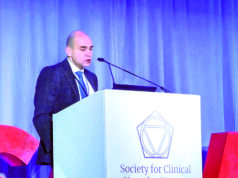
Endoscopic saphenous vein stripping superior to traditional stripping.
In a study presented by Dr Afshin Assadian, Department of General and Vascular Surgery, Wilhelminenspital Vienna, Austria, at the recent VEITHSymposium in New York, endoscopically assisted stripping of the greater saphenous vein had superior results compared to traditional stripping in regard to postoperative quality of life and function. Assadian began his presentation by stating that crossectomy and stripping is no longer regarded as ’gold standard’ for treating varicose veins. He also highlighted that alternative minimal invasive therapies like endovenous laser treatment (EVLT) or endovenous radiofrequency obliteration (RFO) of the greater saphenous vein have other inherent complications (such as thermal damage of the skin or the nerve and thrombus reaching into the deep venous system). “In addition, such methods are not suitable for large tortuous vessels and results from a large RadioFrequency Obliteration Registry demonstrated that laser or RF ablation is not suitable if you are obese (body mass index over 25),” Assadian told Vascular News.Study design
As a result, a pilot study was undertaken to compare two methods of crossectomy and removal of the greater saphenous vein from the groin to the distal insufficiency region. The aim was to assess whether endoscopically assisted greater saphenous vein stripping is comparable both surgically and regarding patient quality of life with the standard surgical technique of crossectomy and stripping. A total of 60 consecutive patients were enrolled in the study and randomized to endoscopic (n=30) and to traditional (n=30) stripping. The patients age ranged from 30 to 75 years (mean 53 years), 18 patients were male, 42 female. Combined endpoints of the study were haematoma at the thigh, ecchymosis, seroma, wound healing complications, infections and the change of score for the SF-36 quality of life assessment during follow up at one and four weeks postoperatively. The device utilized in the study was the Clear Glide endoscopic vein harvesting device (Datascope Cardiac Assist). Following surgery, all patients received compression therapy (sterile gauze dressing and covered with a compression bandage). The bandages were removed after 24 hours and Class II compression stockings were applied until the first follow up visit (seven to nine days postoperatively). Patients in the conventional group continued with class II thigh high compression until the second follow up (four weeks), patients in the endoscopic group had to wear Class II compression up to the knee until the second follow up.
Results
The outcomes revealed that the combined rate of postoperative morbidity was 32 events (53%), 13 (42%) events in the endoscopic and 19 (63%) in the conventional group (not significant). In addition, in an quality of life assessment (Medical Outcomes Study Short Form [SF-36] assessment) between the groups one week postoperatively, patients in the endoscopic group had a significantly less pain (p=0.03), and at four weeks, patients in the endoscopic group had significantly less pain (p<0.005), better physical function (p<0.005) and physical role (p=0.01). For all other parameters, there was no significant difference noted.
Conclusion
In conclusion, Assadian said that endoscopically assisted stripping of the greater saphenous vein has superior results compared to traditional stripping regarding postoperative quality of life. Impoortantly, he said that those patients with a BMI above 25, the endoscopic method seemed to be especially beneficial. The results indicate that the endoscopic method seems to halve the event rate vs. conventional surgery, and is preferred by the patient as this method requires two to seven days of leg compression vs. two weeks.












